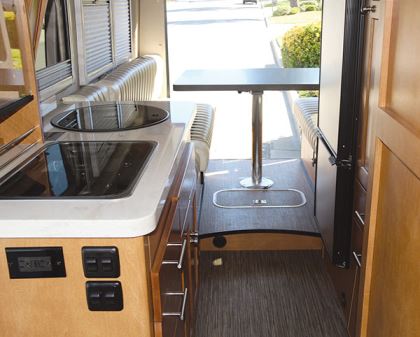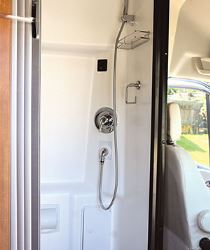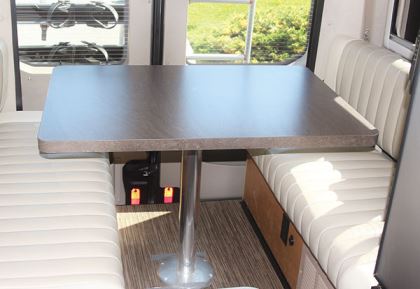A new Type B motorhome from the Winnebago Touring Coach Division.
By Lazelle Jones
July 2017
The prowess, utility, and functionality of the Ford Transit was proven in utility van markets around the world, long before it was introduced in North America.  Because of the Transit’s expected longevity as part of Ford Motor Company’s cargo van lineup, Winnebago chose it as the platform around which to design and build the new Paseo Type B motorhome.
Because of the Transit’s expected longevity as part of Ford Motor Company’s cargo van lineup, Winnebago chose it as the platform around which to design and build the new Paseo Type B motorhome.
The Transit features Ford unibody construction and is powered by a 3.5-liter V-6 EcoBoost direct-fuel-injected gasoline engine with twin turbochargers. The engine comes coupled to a Select Shift six-speed electronic transmission and develops 310 horsepower and 400 pound-feet of torque that’s delivered to the rear wheels. The overall fuel economy of the Paseo motorhome averages approximately 15 mpg on the highway. The only drivetrain option that Winnebago Industries has Ford include on the Transit is the limited-slip differential. This feature prevents rear-wheel traction issues should road conditions turn slippery.
The Ford factory automotive paint, Magnetic, is the exterior color available. However, Winnebago does offer the Magnetic Deluxe option, which has the front and rear bumpers and cowling painted to match the exterior shell. Recently, I examined a Paseo with this optional exterior.
Construction And Design
The structural integrity of this Ford unibody chassis/van is not compromised by the modifications Winnebago employees make to the unit during the conversion ![]() process. Strategically placed penetrations are made to the walls, floor, roof, and interior of the chassis/van shell to accommodate the residential features that are added. The large windows Ford has engineered into the Transit are retained, as are the sliding cargo door on the side and the rear swing-out doors. The rear cargo doors open up to 90 degrees for ease of access and loading; they can be opened fully by releasing a mechanical latch, which permits them to swing around to meet the exterior stops Ford has added to the outside of the Transit body.
process. Strategically placed penetrations are made to the walls, floor, roof, and interior of the chassis/van shell to accommodate the residential features that are added. The large windows Ford has engineered into the Transit are retained, as are the sliding cargo door on the side and the rear swing-out doors. The rear cargo doors open up to 90 degrees for ease of access and loading; they can be opened fully by releasing a mechanical latch, which permits them to swing around to meet the exterior stops Ford has added to the outside of the Transit body.
The wall penetrations Winnebago employees add include cuts for water, electrical, and heating. The floor is modified to accommodate plumbing for the 21-gallon gray-water tank and the 18-gallon black-water tank, which are located below the interior floor. The 26-gallon fresh-water tank and all supply lines are sequestered in the main cabin. This provides added protection for the fresh-water tank during cold-weather camping. Using the Paseo in frigid weather, where sustained hard freezes occur, requires a prudent decision. However, moderate winter temperatures can be accommodated by operating the furnace to keep inside temperatures comfortable. In fact, the Paseo has been insulated for extended-season RVing.
Interior Subfloor and Wall Surfaces
The interior subfloor features sheets of ¾-inch marine-grade plywood that’s dressed on the top with vinyl flooring (two floor covering choices are available). Winnebago employees outfit the ceiling to accommodate a 13,500-Btu roof air conditioner and the holding tank vents that are plumbed to the top of the coach. Insulation is added to the exterior walls and roof: a woven fabric batting with an R-factor of 7.5. The patio sliding door and the rear doors also have batt insulation.
Interior wall surfaces are dressed with fabric-covered panels. The ceiling features a soft-touch surface that’s matched to the interior décor package the coach owner selects. Three interior décor schemes are offered — Crosshatch, Rave, and Urban — with Washed Maple and Coffee-Glazed Vienna Maple wood choices offered for the cabinetry.
Utility and Convenience
The Paseo is configured to sleep two adults. However, the utility and convenience that are available for chauffeuring around several Little League or soccer players, or making trips to the supermarket or hardware store, are obvious. Seat belts accommodate four adults on the rear opposing bench seats (two belts per seat). Add the pilot and copilot seats, and the Paseo can provide safe transport for six, whether it’s a jaunt around town or a longer drive.
With an overall exterior length of 22 feet 1 inch, the Paseo obviously can be navigated through heavy, congested traffic easier than with a larger motorhome; plus, finding a parking spot is less of an issue. Also, Type B motorhomes may meet residential parking codes in more communities. (Because parking requirements vary, RVers need to make sure what is go and no-go when it comes to parking a Type B motorhome on their driveway or at the curb in a residential area.)
The Paseo is particularly appealing in today’s Type B motorhome market because of the manner in which Winnebago designers have addressed residential needs and comforts in a recreation vehicle designed for those seeking an active lifestyle.
The Exterior
It all begins on the outside, starting with the Paseo’s optional rear ladder/roof rack system. When the ladder is not in use, it attaches to one of the Paseo’s rear-hinged cargo doors. The ladder can be removed from its stowed position and placed alongside the coach to provide access to the rooftop cargo rack. The rack i ncorporates adjustable cross members (no tools required) and is a perfect place to attach modular storage pods. Up to 300 pounds of cargo can be carried this way. RVers will need to remember that items placed on the roof will increase the Paseo’s exterior height (which specs indicate is 9 feet 10 inches) and note this for clearance considerations.
ncorporates adjustable cross members (no tools required) and is a perfect place to attach modular storage pods. Up to 300 pounds of cargo can be carried this way. RVers will need to remember that items placed on the roof will increase the Paseo’s exterior height (which specs indicate is 9 feet 10 inches) and note this for clearance considerations.
Another exterior option is a removable bike rack. When mounted to the Paseo’s other rear cargo door, this rack can carry two adult-size bicycles on two retractable trays. Both rear doors swing open when these two appurtenances are attached, with no obstructions.
Likewise, the ladder and bike rack do not interfere with the 5,000-pound drawbar/500-pound-maximum vertical tongue weight hitch receiver, which comes standard on the Paseo. Equipped with a seven-pin electrical connector, the coach is ready to go for towing. Those who are into boating, or who travel with off-highway vehicles (motorcycles, quads, etc.) where a utility trailer is needed, will want to note that the Paseo is rated to tow up to 5,000 pounds.
The Paseo’s gross vehicle weight rating (GVWR) is 10,360 pounds. The unloaded vehicle weight of my test unit came to 8,200 pounds, leaving 2,160 pounds for cargo and passengers.
Awning
A final exterior feature to note is standard on the Paseo: an armless, power patio awning with LED lighting. The 13-foot electric awning features a wind sensor that automatically retracts the awning when sustained winds or wind gusts are detected. The coach stereo system can be paired to a user’s smartphone via Bluetooth and enjoyed through exterior speakers located below the awning.
The Interior
The Paseo’s cockpit is quintessential Ford. Its layout will be familiar immediately to anyone who has driven a large sedan or SUV; even motorhome novices can  slide behind the wheel, adjust the seat and mirrors, and be on their way to vacationland. The cockpit features the Ford factory-installed, voice-activated SYNC 3, which includes an easy-to-read color touch screen on the dash and displays phone, audio, and navigation functions.
slide behind the wheel, adjust the seat and mirrors, and be on their way to vacationland. The cockpit features the Ford factory-installed, voice-activated SYNC 3, which includes an easy-to-read color touch screen on the dash and displays phone, audio, and navigation functions.
The passenger seat swivels to face the cabin area. A small cabinet complex sits directly behind the passenger seat, where a flip-up table instantly can be put into service when the chair is facing rearward.
Winnebago employees install a framed, retractable, floor-to-ceiling screen that pulls across the side cargo door opening; this enables the door onto the patio area to remain open while providing ventilation, keeping out insects, etc. A similar screen covering has been added to the rear cargo doors.
“Wet Bath”
Opposite the patio cargo door is the full-service, fixed “wet bath.” Winnebago designers engineered the street-side bath area farther forward than in similar models; doing so avoids protruding wheel wells and maximizes space. This ABS-plastic molded module is a unitized structure that incorporates the shower walls and ceiling; a marine-style toilet that’s sealed to the floor; and a fold-down sink above the toilet. Also included are a light and a power vent.
Bathers pull a shower curtain across the sliding accordion shower door to keep the water inside. Depending on the person’s height, he or she can stand in the shower or use the toilet as a seat. A handheld showerhead with an on-off control allows the user to manage the fresh water supply. A pump between the shower drain and the gray-water holding tank facilitates removal of water from the shower pan.
Immediately aft of the bath area is a floor-to-ceiling complex that includes two large, roll-out drawers at the bottom and, above them, a three-quarter-length wardrobe with an interior shelf. The depth and width of the wardrobe is sufficient for hanging garments.
Next to this cabinet complex is the 6.0-cubic-foot, two-door, compressor-driven refrigerator-freezer by NovaKool, which is powered by 12-volt-DC (5.5 amps running/3.1 amps average).
More Interior Details
Two Group 31 AGM house batteries provide all the power needed to support all DC house systems, including keeping perishables fresh and frozen foods “block hard” in the refrigerator-freezer. The house batteries are kept charged by shore power; a 2.8-kilowatt gasoline-fueled auxiliary generator; the engine-driven alternator; and optional roof solar panels, if so equipped.
Above the refrigerator is a 1.0-cubic-foot microwave-convection oven. This appliance is operable only when the coach is connected to shore power or when the generator is running.  The gen set and the 30-amp shore cable are the power sources for the microwave oven, the roof air conditioner, and the 110-volt power outlets in the cabin and patio area. There is no inverter.
The gen set and the 30-amp shore cable are the power sources for the microwave oven, the roof air conditioner, and the 110-volt power outlets in the cabin and patio area. There is no inverter.
Midcoach across the center aisle from the microwave and refrigerator is the rest of the full-service galley. A power hood and light hang above the two-burner LP cooktop, which is set into the Corian countertop alongside a stainless-steel sink, both with covers. A stack of three roll-out drawers and a double-door cabinet sit beneath the countertop; a flip-up extension on the right side extends workspace. Storage behind the cooktop and a window above the sink complete the galley.
A 19-inch LED flat-screen television is mounted on the wall left of the street-side refrigerator. An adjustable arm enables the TV to be positioned as needed for viewing. Further entertainment is afforded by the stereo system with AM-FM radio, Bluetooth, a CD-DVD player, and remote.
In the rear of the coach, overhead cabinets employ sliding doors. All cabinet faces have aluminum extrusions and LED accent lighting. Peer inside the overhead cabinets and you’ll see Winnebago’s patented Smart Storage design: The interior panels have pockets formed into the openings in the van wall structure.
Flex Bed System
For dining and sleeping, the rear third of the coach has been well attended to with Winnebago’s own Flex Bed system. The tucked, upholstered seats that line both sides of the unit combine with an oversized dining table with a center post to form the heart and soul of this salon area. At bedtime, the table post is removed; the tabletop drops down to become part of the bed platform; and the seats adjust down to become the mattress. The cross-coach sleeping measurement is 53 inches by 72 inches, a dimension to keep in mind for tall RVers.
Throughout the coach, thermal accordion-style day-night shades can be raised and lowered as needed for privacy or comfort.
At the end of the day, relaxing in the Paseo, one can say, “Life is good.”
The 2018 Winnebago Paseo carries a base manufacturer’s suggested retail price of $127,535. My test coach came to $135,315 with these options: heated drainage system; luggage rack; exterior ladder; Magnetic Deluxe exterior; Ultraleather cab seats; 100-watt solar panel; bike rack; roof vent.
SPECS
MANUFACTURER
Winnebago Industries, P.O. Box 152, Forest City, IA 50436; (641) 585-3535; www.winnebagoind.com
MODEL
Paseo
FLOOR PLAN
48P
SLIDEOUTS
N/A
CHASSIS
Ford Transit
ENGINE
Ford EcoBoost 3.5-liter V-6; 310-horsepower at 5,000 rpm; 400 pound-feet torque at 2,250 rpm
TRANSMISSION
6-speed automatic
AXLE RATIO
3.73 to 1
TIRES
195/75 R 16 C
WHEELS
16 inches, stainless-steel liners; stylized alloy wheels optional
WHEELBASE
148 inches
BRAKES
disc
SUSPENSION
front — independent MacPherson strut with stabilizer bar;
rear — leaf spring with heavy-duty shock absorbers
STEERING
power
ALTERNATOR
250 amps
BATTERIES
chassis — (2) 70 amp-hour, combined
house — (2) Group 31 deep-cycle
INVERTER
none
ELECTRICAL SERVICE
30 amps
AUXILIARY GENERATOR
2.8-kw Cummins Onan gas
EXTERIOR LENGTH
22 feet 1 inch (without ladder)
EXTERIOR WIDTH
88 inches (without mirrors)
EXTERIOR HEIGHT
9 feet 10 inches
INTERIOR HEIGHT
6 feet 6 inches
GROSS COMBINATION WEIGHT RATING (GCWR)
12,600 pounds
GROSS VEHICLE WEIGHT RATING (GVWR)
10,360 pounds
GROSS AXLE WEIGHT RATING (GAWR)
front — 4,130 pounds
rear — 7,275 pounds
AS-TESTED WEIGHT
(weighed with ½-full fuel)
front axle — 2,980 pounds;
rear drive axle — 5,080 pounds;
total — 8,200 pounds
OCCUPANT & CARGO CARRYING CAPACITY (OCCC)
2,055 pounds
FRAME CONSTRUCTION
steel
INSULATION
batt; R-7.5
FRESH WATER CAPACITY
26 gallons
HOLDING TANK CAPACITIES
gray water — 21 gallons;
black water — 18 gallons
FUEL CAPACITY
25 gallons
FUEL REQUIREMENTS
gasoline
PROPANE CAPACITY
6 gallons
WATER HEATER
2.6-gallon quick-recovery Truma Combi
WATER SYSTEM
demand
HEATING SYSTEM
Truma Combi Eco Plus Heating
AIR CONDITIONING
(1) 13,500-Btu
REFRIGERATOR
compressor-driven 12-volt
TOILET
marine-style with foot pedal and sprayer
WARRANTY
coach — 12 months/15,000 miles;
chassis — 36 months/36,000 miles;
powertrain — 60 months/60,000 miles
BASE SUGGESTED RETAIL PRICE
$127,535
PRICE AS TESTED
$135,315

